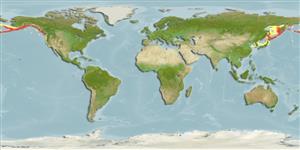Preferred temperature (Ref.
115969): 1.1 - 5.9, mean 3.7 (based on 205 cells).
Phylogenetic diversity index (Ref.
82804): PD
50 = 0.5000 [Uniqueness, from 0.5 = low to 2.0 = high].
Bayesian length-weight: a=0.01023 (0.00652 - 0.01607), b=3.10 (2.97 - 3.23), in cm Total Length, based on LWR estimates for this species & Genus-body shape (Ref.
93245).
Trophic level (Ref.
69278): 4.3 ±0.3 se; based on diet studies.
Widerstandsfähigkeit (Ref.
120179): sehr niedrig, Verdopplung der Population dauert mehr als 14 Jahre. (tmax=157; k=0.04).
Prior r = 0.02, 95% CL = 0.01 - 0.04, Based on 1 stock assessment.
Fishing Vulnerability (Ref.
59153): High to very high vulnerability (74 of 100).
